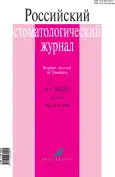Оптимизация течения раневого процесса у больных одонтогенными флегмонами челюстно-лицевой области
- Авторы: Швец О.В.1, Гайворонская Т.В.1, Есауленко Е.Е.1, Быкова Н.И.1
-
Учреждения:
- ФГБОУ ВО «Кубанский государственный медицинский университет» Минздрава России
- Выпуск: Том 24, № 6 (2020)
- Страницы: 387-390
- Раздел: Клинические исследования
- URL: https://journals.rcsi.science/1728-2802/article/view/65249
- DOI: https://doi.org/10.17816/1728-2802-2020-24-6-387-390
- ID: 65249
Цитировать
Аннотация
Цель исследования — повышение эффективности коррекции течения раневого процесса у больных одонтогенными флегмонами челюстно-лицевой области с использованием средства энерготропной и антиоксидантной направленности действия. Материал и методы. Объектом клинического исследования были 42 больных одонтогенными флегмонами челюстно-лицевой области, разделенные на две группы: группу сравнения, получавшую традиционное лечение, и основную группу, в схему терапии которой был включен цитофлавин. Результаты. В основной группе больных появление первых грануляций происходило в 2,1 раза быстрее (в среднем на 3-и сутки) по сравнению с грануляционной тканью у больных группы сравнения. Признаки краевой эпителизации ран у больных основной группы появлялись почти на 3 суток раньше (в среднем на 6-е сутки), чем в группе сравнения, а в среднем на 7-е сутки уже выполнялось наложение вторичных швов, что в 1,6 раза было быстрее аналогичного параметра 2-й группы, что наглядно свидетельствует об ускорении репаративных процессов. Заключение. Динамика клинических проявлений свидетельствует о сравнительной эффективности дополнительного использования цитофлавина в составе комплексной терапии. Это подтверждается ускоренными сроками очищения раны, появления в ней грануляций, эпителизации краев раны и наложения вторичных швов.
Ключевые слова
Полный текст
Открыть статью на сайте журналаОб авторах
О. В. Швец
ФГБОУ ВО «Кубанский государственный медицинский университет» Минздрава России
Email: corpus@ksma.ru
Россия, Краснодар
Татьяна Владимировна Гайворонская
ФГБОУ ВО «Кубанский государственный медицинский университет» Минздрава России
Автор, ответственный за переписку.
Email: corpus@ksma.ru
доктор медицинских наук, заведующий кафедрой хирургической стоматологии и челюстно-лицевой хирургии ФГБОУ ВО КубГМУ Минздрава России
Россия, КраснодарЕ. Е. Есауленко
ФГБОУ ВО «Кубанский государственный медицинский университет» Минздрава России
Email: corpus@ksma.ru
Россия, Краснодар
Н. И. Быкова
ФГБОУ ВО «Кубанский государственный медицинский университет» Минздрава России
Email: corpus@ksma.ru
Россия, Краснодар
Список литературы
- Дидковский Н.А., Малашенкова И.К., Крынский С.А., Батырбекова Ф.Р. Роль иммунопатологических механизмов в патогенезе гнойно-воспалительных заболеваний челюстно-лицевой области. Часть 1 // Успехи современной биологии. 2015. Т. 135, № 6. С. 599–609.
- Саркисов Д.С., Пальцын A.A., Музыкант Л.И. Морфология раневого процесса. В кн.: Раны и раневая инфекция: руководство для врачей. Москва: Медицина, 1990. С. 38–83.
- Bertossi D., Barone A., Iurlaro A., et al. Odontogenic orofacial infections // J Craniofac Surg. 2017. Vol. 28, № 1. P. 197–202.
- Агапов В.С., Царев В.Н., Пиминова И.А. Клинико-микробиологический анализ результатов местного применение перфторана в комплексном лечении больных с одонтогенными флегмонами лица и шеи // Институт стоматологии. 2005. № 2. С. 50–52.
- Попов К.А., Федосов С.Р., Малышко В.В., и др. Экспериментальное обоснование применения нанокластерного серебра для лечения гнойных ран // Кубанский научный медицинский вестник. 2016. № 4. С. 141–146.
- Григорьев А.Г., Власов А.П., Григорьева А.А., и др. Интенсивность липопероксидации при гнойно-воспалительных процессах в динамике комбинированной терапии // Современные проблемы науки и образования. 2015. № 2–3. С. 211.
- Петросян Н.Э., Беляков Н.А., Петросян Э.А. Применение натрия гипохлорита и малой аутогемотерапии экстракорпорально окисленной крови у больных с флегмонами челюстно-лицевой области. Влияние на реологические свойства крови // Вестник интенсивной терапии. 2004. Т. 5. С. 121–124.
- Malanchuk V., Sidoryako V.A., Vardzhapetian S. Modern treatment methods of phlegmon in the maxillo-facial area and neck // Georgian Med. News. 2019. Т. 294. С. 57–61.
- Быков И.М., Любченко Д.А., Попов К.А. Изменения биохимических показателей у больных с зависимостью от психостимуляторов на фоне метаболической коррекции // Медицинский вестник Северного Кавказа. 2019. Т. 14, № 2. С. 352–355.
- Боев И.А., Годовалов А.П., Штраубе Г.И., Антаков Г.И. Особенности заболеваемости флегмоной челюстно-лицевой области с оценкой эффективности детоксикационной терапии // Пермский медицинский журнал. 2019. Т. 92, № 2. С. 29–35.
- Greenstein G., Greenstein B. Clinical management of acute orofacial infections // Compend Contin Educ Dent. 2015. Т. 36, № 2. С. 96–103.
Дополнительные файлы







